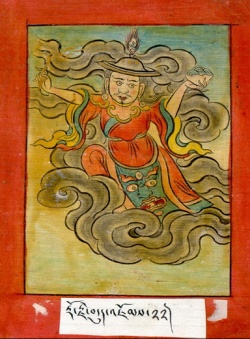Nanam Dorje Dudjom
Nanam Dorje Dudjom (Tib. སྣ་ནམ་རྡོ་རྗེ་བདུད་འཇོམས་, Wyl. sna nam rdo rje bdud 'joms) (8th-9th cent.) — one of King Trisong Detsen’s ministers, sent to Nepal to invite Padmasambhava to Tibet. He became one of Guru Rinpoche's main twenty-five disciples. When receiving empowerment from Guru Rinpoche, his flower fell on the mandala of Vajrakilaya. Through the practice he became an accomplished mantrika, who could fly with the speed of the wind and pass through solid rock. The name Dorje Dudjom means ‘Indestructible Subduer of Mara.’
Incarnations
- Rigdzin Gödem (1337-1408)
- Lekden Dudjom Dorje (1512-1625?)
- Pema Trinlé (1641-1718), the great vidyadhara of Dorje Drak Monastery in Central Tibet
He is also the root incarnation of
Oral Accounts of the Life of Nanam Dorje Dudjom
- Khenpo Jikmé Phuntsok, Lerab Ling, 24 August 1993
- Nyoshul Khen Rinpoche, Lerab Ling, Summer 1996
Source
Dorje Dudjom (rdo rje bdud 'joms) was born into the Zhang (zhang) family of the Nanam clan (sna nam), in Tsangrong (gtsang rong). Also known as Trishi of Ba (rba khri gzigs), Dorje Dudjom became a minister to King Trison Detsen (khri srong lde'u btsan) while still a young man.
According to the Orgyen Lingpa's (o rgyan gling pa) biography of Padmasambhava, the Padma Katang (pad+ma bka' thang), Dorje Dudjom was part of the party that invited Padmasambhava to Tibet.
He and his companions, Śākyaprabhā of the Chim (chims) clan and Pelgyi Sengge (dpal gyi seng ge) first gained permission from King Sūrya and then traveled with Padmasambhava to Nepal, where the master remained for three months after sending the Tibetans on ahead. After Padmasambhava tarried again in Mangyul (mang yul), on the Nepali border, Trison Detsen again sent the envoys to the border, where they offered Padmasambhava gold dust as an incentive to return with them to Tibet. To their dismay Padmasambhava threw the dust into the wind, but he then transformed rocks and soil into gold and jewels, earning their faith.
Dorje Dudjom, under the name Trishi of Ba, is also counted among the early translators who made the dangerous journey to India to bring back scripture, and he contributed to the translation of the Vinaya.
When Padmasambhava initiated him, his flower fell onto Jigten Choto ('jig rten mchod stod). While meditating in a pitch dark cave he had a vision that the construction of the temple at Samye was nearly completed. He emerged through a small chink in the rock, leaving behind a large passageway. While practicing the Vajrakīlaya sādhana Hepori (he po ri) near Samye he cut off thought at its root and demonstrated his attainment by implanting his kila dagger in a rock. He is said to have traveled in the sky at the speed of wind and passed unhindered through a mountain near Samye.
Later in his life he returned to Tsangrong, practicing at Drakmar Ke'u Tsang (brag dmar ke'u tshang), and also practicing in Yardrok (yar 'brog), at a site also called Drakmar Ke'u Tsang. He is said to have translated many tantric texts there.
Dorje Dudjom is also listed as a student of Kharchen Pelgyi Wangchuk (mkhar chen dpal gyi dbang phyug).
His reincarnations include Rigdzin Godem Ngodrub Gyeltsen (rig 'dzin rgod ldem dngos grub rgyal mtshan, 1337-1409), Rigdzin Lekdenje ([[rig 'dzin legs}} ldan rje]], 15th c), and Jamyang Khyentse Wangpo ('jam dbyangs mkhyen brtse'i rdo rje, 1813-1892).
According to the Blue Annals, Rongzom Chokyi Zangpo (rong zom chos kyi bzang po, 1042-1136) received Dorje Dudjom's transmission line of the Semde (sems sde) teachings.
Sources
- Tarthang Tulku. 1975. Bringing the Teachings Alive. Cazadero, CA: Dharma Publishing, pp. 66-67.
- Roerich, George, trans. 1996. The Blue Annals. 2nd ed. Delhi: Motilal Banarsidas, p. 166.
- Orgyen Lingpa. The Life and Liberation of Padmasambhava (Padma bka' thang). Gustave-Charles Toussaint, Kenneth Douglass, and Gyendolyn Bays, trans. Emeryville, CA: Dharma Publishing, p. 368.
- 'Jam mgon kong sprul blo gros mtha' yas. 2007. Gter ston brgya rtsa. In Rin chen gter mdzod chen mo. New Delhi: Shechen, v.1 pp. 386-387.
- Dudjom Rinpoche. 2002. The Nyingma School of Tibetan Buddhism. Gyurme Dorje and Matthew Kapstein, trans. Boston: Wisdom.
- Gu ru bkra shis. 1990. Gu bkra'i chos 'byung. Beijing: Krung go'i bod kyi shes rig dpe skrun khang, pp. 171-172.
Arthur Mandelbaum
August 2007
Source
The following biography is from the Treasury of Lives, a biographical encyclopedia of Tibet, Inner Asia and the Himalaya. The biography is written by Arthur Mandelbaum.
http://www.treasuryoflives.org/biographies/view/Nanam-Dorje-Dudjom/303

